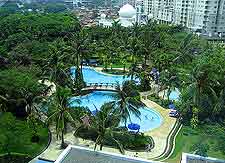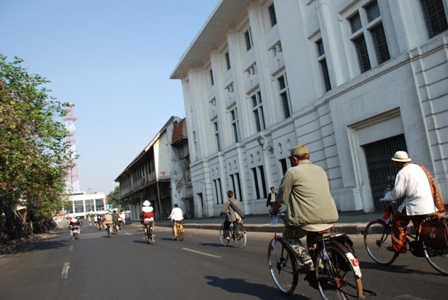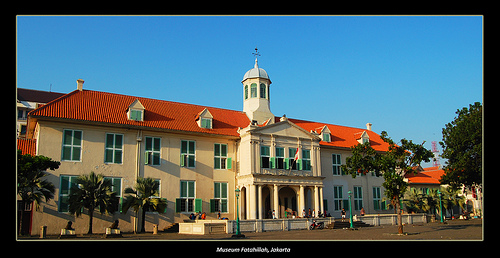Indonesian cuisine reflects the vast variety of people that live on the 6,000 populated islands that make up Indonesia. There is probably not a single "Indonesian" cuisine, but rather, a diversity of regional cuisines influenced by local Indonesian culture and foreign influences.
Throughout its history, Indonesia has been involved in trade due to its location and natural resources. Indonesia’s indigenous techniques and ingredients, at least in the Malay World parts, are influenced by India, the Middle East, China and finally Europe. Spanish and Portuguese traders brought New World produce even before the Dutch came to colonize most of Indonesia.
The Indonesian island of Maluku, which is famed as "the Spice Island," also contributed to the introduction of native spices to Indonesian and global cuisine. The cuisine of Eastern Indonesia is similar to Polynesian and Melanesian cuisine.Sumatran cuisine, for example, often shows its Middle Eastern and Indian influence, featuring curried meat and vegetables, while Javanese cuisine is rather more indigenously developed. Elements of Indonesian Chinese cuisine can be seen in Indonesian cuisine: items such as bakmi (noodles), bakso (meat balls) and lumpia have been completely assimilated.


The most popular dishes that originated in Indonesia are now common across most of Asia. Popular Indonesian dishes such as satay, beef rendang, and sambals are also favored in Malaysia and Singapore. Soy-based dishes, such as variations of tofu (tahu) and tempe, are also very popular.
Tempe is regarded as a Javanese invention, a local adaptation of soy-based food fermentation and production. Indonesian meals are commonly eaten with the combination of a spoon in the right hand and fork in the left hand, although in many parts of the country (such as West Java and West Sumatra) it is also common to eat with one's hands.
In restaurants or households that commonly use bare hands to eat, like in traditional Sundanese or Minangkabau restaurants, they usually serve kobokan, a bowl of tap water with a slice of lime in it to give a fresh scent. This bowl of water with lime in it should not to be consumed; it's used to wash one's hand before and after eating with bare hand.
RiceRice is a staple for all classes in contemporary Indonesia, and it holds a central part in Indonesian culture: it shapes the landscape; is sold at markets; and is served in most meals as a savoury and sweet food.
 Rice is most often eaten as plain rice (nasi putih) with just a few protein and vegetable dishes as side dishes. It is also served, however, as ketupat (rice steamed in woven packets of coconut fronds), lontong (rice steamed in banana leaves), intip (rice crackers), desserts, vermicelli, noodles, brem (rice wine), and nasi goreng (fried rice).Rice was only incorporated into diets, however, as either the technology to grow it or the ability to buy it from elsewhere was gained.
Rice is most often eaten as plain rice (nasi putih) with just a few protein and vegetable dishes as side dishes. It is also served, however, as ketupat (rice steamed in woven packets of coconut fronds), lontong (rice steamed in banana leaves), intip (rice crackers), desserts, vermicelli, noodles, brem (rice wine), and nasi goreng (fried rice).Rice was only incorporated into diets, however, as either the technology to grow it or the ability to buy it from elsewhere was gained.
Evidence of wild rice on the island of Sulawesi dates from 3000 BCE. Evidence for the earliest cultivation, however, comes from eighth century stone inscriptions from the central island of Java, which show kings levied taxes in rice. Divisions of labour between men, women, and animals that are still in place in Indonesian rice cultivation, can be seen carved into the ninth-century Prambanan temples in Central Java: a Water buffalo attached to a plough; women planting seedlings and pounding grain; and a man carries sheaves of rice on each end of a pole across his shoulders.

In the sixteenth century, Europeans visiting the Indonesian islands saw rice as a new prestige food served to the aristocracy during ceremonies and feasts.Rice production requires exposure to the sun. Rice production in Indonesian history is linked to the development of iron tools and the domestication of Wild Asian Water Buffalo as water buffalo for cultivation of fields and manure for fertilizer.
Once covered in dense forest, much of the Indonesian landscape has been gradually cleared for permanent fields and settlements as rice cultivation developed over the last fifteen hundred years.Other staple foods in Indonesia include maize (in drier regions such as Madura and the Lesser Sunda Islands), sago (in Eastern Indonesia), cassava (dried cassava, locally known as 'tiwul' is an alternate staple food in arid areas in Java such as Gunung Kidul and Wonogiri) and root tubers (especially in hard times).
Peanut SauceOne of the main characteristic of Indonesian cuisine is the wide applications of bumbu kacang (peanut sauce) in many of Indonesian signature dishes such as satay, gado-gado, karedok, ketoprak, pecel. It usually applied upon the main ingredients (meat or vegetable) to give the taste, or might simply as dipping sauce such as sambal kacang (a mixture of grinded chilli and fried peanuts) for otak-otak or ketan. Introduced from Mexico by Portuguese and Spanish merchants back in 16th century, peanuts took place within Indonesian cuisine as the popular sauce. Indonesian peanut sauce represents a sophisticated, earthy thing rather than a sweet, gloppy sauce.

The peanut thrived in the tropical environment of Southeast Asia, and today, they can be found roasted and chopped finely, topping a variety of dishes and in marinades and dipping sauces. Peanut sauce reach its sophistication in Indonesia, with the delicate balance of taste acquired from various ingredients according to each recipe of peanut sauce; fried peanuts, gula jawa (coconut sugar), garlic, shallot, ginger, tamarind, lemon juice, lemongrass, salt, chilli, pepper, sweet soy sauce, grinded together and mixed with water to acquire right texture.
The secret to good peanut sauce is “not too thick and not too watery.” Indonesian peanut sauce tends to be less sweet than the Thai one (which is a hybrid adaptation). Gado-gado is eaten with peanut sauce throughout Indonesia showcasing the delicate balance of sweet, spicy and sour.
Coconut MilkGiven the location of Indonesia as a tropical country with abundant tropical produce such as coconut, Indonesia, since ancient times. has developed various uses of this plant. Another main characteristic of Indonesian cuisine is the wide applications of santan (coconut milk) in many of Indonesian dishes like rendang, soto, sayur lodeh, opor ayam, to desserts such as es cendol, and es doger. Coconut milk's use does not exclusively belongs to Indonesian cuisine, since it also can be found in Indian, Samoa, Thailand, Malaysian, Philippines, to Brazilian cuisine. However the use of coconut milk is quite extensive in Indonesia.

The extensive uses of coconut milk especially found in Minangkabau cuisine, while in Minahasan (North Sulawesi) cuisine, coconut milk rather absent except for Minahasan cakes and desserts such as klappertart. In Indonesian cuisine, coconut milk can be found in two type, thin coconut milk and thick coconut milk, the difference is depends on the amount of water in it. Thin coconut milk usually being use for soups such as sayur lodeh and soto, while creamy thick one use for rendang and desserts. It can be acquired freshly from shredded coconut flesh in traditional market, to processed coconut milk in carton packages at supermarket.

After the juice (milk) being extracted from shredded coconut flesh to acquire coconut milk, the ampas kelapa (leftover coconut flesh) still can be used as urap, seasoned and spiced shredded coconut flesh mixed together with vegetables.
Urap is quite similar to gado-gado except the peanut sauce is replaced by shredded coconut one. This leftoever of shredded coconut flesh also can be cooked, sauted and seasoned to make serundeng, the almost powder-like sweet and spicy coconut granules. Serundeng can be mixed with meat such as serundeng daging (beef serundeng) or sprinkled on top of other dishes such as soto or ketan (sticky rice). An example on heavy use of coconut is Buras from Makassar, rice wrapped in banana leaf cooked with coconut milk and sprinkled with coconut powder similar to serundeng.
Meal TimesIn western and central Indonesia, the main meal is usually cooked in the late morning, and consumed around midday. In many families there is no set meal time where all members are expected to attend. For this reason, most of the dishes are made such that they can last and remain edible even if left on the table at room temperature for many hours.
The same dishes are then re-heated for the final meal in the evening. Most meals are built around a cone-shaped pile of long-grain, highly polished rice. A meal may include a soup, salad (or more commonly sauteed vegetables with garlic), and another main dish. Whatever the meal, it is accompanied by at least one, and often several relishes that are called sambals.
In eastern Indonesia, where the natives are more influenced by Pacific islander cultures such as on the island of Papua and Timor, the meals can be centered around other sources of carbohydrates such as sago and/or grain.
Feasts: Tumpeng and Rijsttafel
Many of Indonesian traditional customs and ceremony incorporated food and feast. One of the best example of Indonesian feast is tumpeng. Originated from Java, tumpeng is a cone shaped rice surrounded by assorted of Indonesian dishes. Traditionally featured in selamatan ceremony, the cone shape of rice is made by using cone-shaped weaved bamboo container. The rice itself could be plain steam rice, uduk rice (cooked with coconut milk), or yellow rice (rice colored with kunyit or turmeric).
The rice surrounded by assorted of Indonesian dishes, such as urap vegetables, fried chicken, semur (beef in sweet soy sauce), teri kacang (anchovy with peanuts), fried prawn, telur pindang (boiled marble egg), shredded omelette, tempe orek (sweet and dry fried tempeh), perkedel kentang (mashed potato fritters), perkedel jagung (corn fritters),sambal goreng ati (liver in chilli sauce), and many other things.

Tumpeng, the cone shaped rice surrounded by assorted Indonesian dishes.Tumpeng dated back to ancient Indonesian tradition that revered mountains as the abode of ancestors and gods. The cone-shaped rice meant to mimics the holy mountain. The feast served as some kind of thanksgiving for the abundance of harvest or any other blessings. Because of its festivities and celebrative value, up until now tumpeng sometimes used as Indonesian counterpart of birthday cake.Another Indonesian feast, the Rijstafel (Indonesian rice table), is demonstrating colonial opulance and Indonesian cuisine diversity at the same time.
The classic style rijstafel ceremony involved the serving of up to 40 different dishes, by 40 male waiters, bare-footed but dressed in formal white uniforms with blangkon (traditional Javanese caps) on their heads and batik cloth around their waists. The contemporary Indonesian feast adopted western style buffet. It usually can be found in wedding ceremony or any other festivities. Its employed long table with dishes served on it.
The layout of Indonesian wedding ceremony buffet usually employs: the plates, eating utensils (spoon and fork), and paper napkins is placed on one end, followed by rice (plain or fried rice), series of Indonesian (sometimes International) foods, sambal and krupuk (crackers), ended with glass of water on the other end of the table.
Snacks and street foodIn most cities it is common to see Chinese dishes such as bakpao (buns), bakmie (noodles), and bakso (meatballs) sold by street vendors and restaurants alike, often adapted to become Indonesian Chinese cuisine. One common adaptation is that pork is no longer used since the majority of Indonesians are Muslims. Another popular Indonesian street food and snack is siomay and batagor, pempek, bubur ayam (chicken congee), bubur kacang hijau (green beans porridge), satay, nasi and mie goreng (fried rice and fried noodle), toge goreng, laksa, and gorengan (Indonesian assorted fritters).
Indonesian street snack also included ice and sweet beverages, such as es cendol or es dawet, es teler, es cincau, es doger, es campur, es potong, and es puter. Indonesian cakes and cookies often called as jajan pasar (market goodies). Indonesia has a rich collection of snack called kue (cakes and pastry) either savoury or sweet. The popular one such as risoles, pastel, lumpia, lemper, lontong, tahu isi, lapis legit, getuk, bakpia, bika ambon, lupis, lemang, kue pisang, klepon, onde-onde, nagasari, soes, bolu kukus, and many other things.

Street and street-side vendors are common, in addition to hawkers peddling their goods on bicycles or carts. These carts are known as pedagang kaki lima - (named after the 5-foot (1.5 m) wide footpaths in Indonesia, however some people say they are named 'five feet' after the three feet of the cart and two feet of the vendor!), and many of these have their own distinctive call or songs to announce their wares. For example, the bakso seller will hit the side of a soup bowl, whereas mie ayam is announced by hitting a wood block.
FruitIndonesian markets abound with many types of tropical fruit. These are an important part of the Indonesian diet, either eaten freshly, made into desserts (such as es buah), made into savoury and spicy dishes like rujak, fried like pisang goreng (fried banana), or processed into kripik (crispy chips) as snacks like jackfruit or banana chips.

Many of these fruits such as Mangosteen, Rambutan, Jackfruit, Durian, and Banana, are indigenous to Indonesian archipelago; while others have been imported from other tropical countries, although the origin of many of these fruits might be disputed. Banana and Coconut are particularly important, not only to Indonesian cuisine, but also in other uses, such as timber, bedding, roofing, oil, plates and packaging, etc.



































 Rice is most often eaten as plain rice (nasi putih) with just a few protein and vegetable dishes as side dishes. It is also served, however, as ketupat (rice steamed in woven packets of coconut fronds), lontong (rice steamed in banana leaves), intip (rice crackers), desserts, vermicelli, noodles, brem (rice wine), and nasi goreng (fried rice).Rice was only incorporated into diets, however, as either the technology to grow it or the ability to buy it from elsewhere was gained.
Rice is most often eaten as plain rice (nasi putih) with just a few protein and vegetable dishes as side dishes. It is also served, however, as ketupat (rice steamed in woven packets of coconut fronds), lontong (rice steamed in banana leaves), intip (rice crackers), desserts, vermicelli, noodles, brem (rice wine), and nasi goreng (fried rice).Rice was only incorporated into diets, however, as either the technology to grow it or the ability to buy it from elsewhere was gained.



 Tumpeng, the cone shaped rice surrounded by assorted Indonesian dishes.Tumpeng dated back to ancient Indonesian tradition that revered mountains as the abode of ancestors and gods. The cone-shaped rice meant to mimics the holy mountain. The feast served as some kind of thanksgiving for the abundance of harvest or any other blessings. Because of its festivities and celebrative value, up until now tumpeng sometimes used as Indonesian counterpart of birthday cake.Another Indonesian feast, the Rijstafel (Indonesian rice table), is demonstrating colonial opulance and Indonesian cuisine diversity at the same time.
Tumpeng, the cone shaped rice surrounded by assorted Indonesian dishes.Tumpeng dated back to ancient Indonesian tradition that revered mountains as the abode of ancestors and gods. The cone-shaped rice meant to mimics the holy mountain. The feast served as some kind of thanksgiving for the abundance of harvest or any other blessings. Because of its festivities and celebrative value, up until now tumpeng sometimes used as Indonesian counterpart of birthday cake.Another Indonesian feast, the Rijstafel (Indonesian rice table), is demonstrating colonial opulance and Indonesian cuisine diversity at the same time. Street and street-side vendors are common, in addition to hawkers peddling their goods on bicycles or carts. These carts are known as pedagang kaki lima - (named after the 5-foot (1.5 m) wide footpaths in Indonesia, however some people say they are named 'five feet' after the three feet of the cart and two feet of the vendor!), and many of these have their own distinctive call or songs to announce their wares. For example, the bakso seller will hit the side of a soup bowl, whereas mie ayam is announced by hitting a wood block.
Street and street-side vendors are common, in addition to hawkers peddling their goods on bicycles or carts. These carts are known as pedagang kaki lima - (named after the 5-foot (1.5 m) wide footpaths in Indonesia, however some people say they are named 'five feet' after the three feet of the cart and two feet of the vendor!), and many of these have their own distinctive call or songs to announce their wares. For example, the bakso seller will hit the side of a soup bowl, whereas mie ayam is announced by hitting a wood block. Many of these fruits such as Mangosteen, Rambutan, Jackfruit, Durian, and Banana, are indigenous to Indonesian archipelago; while others have been imported from other tropical countries, although the origin of many of these fruits might be disputed. Banana and Coconut are particularly important, not only to Indonesian cuisine, but also in other uses, such as timber, bedding, roofing, oil, plates and packaging, etc.
Many of these fruits such as Mangosteen, Rambutan, Jackfruit, Durian, and Banana, are indigenous to Indonesian archipelago; while others have been imported from other tropical countries, although the origin of many of these fruits might be disputed. Banana and Coconut are particularly important, not only to Indonesian cuisine, but also in other uses, such as timber, bedding, roofing, oil, plates and packaging, etc.
